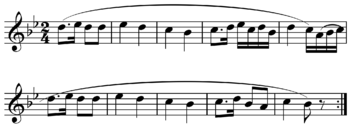

In music, the term period refers to certain types of recurrence in small-scale formal structure. In twentieth-century music scholarship, the term is usually used as defined by the Oxford Companion to Music: "a period consists of two phrases, antecedent and consequent, each of which begins with the same basic motif."[3] Earlier usage varied somewhat, but usually referred to similar notions of symmetry, recurrence, and closure. The concept of a musical period originates in comparisons between music structure and rhetoric at least as early as the 16th century.[4]
- ^ White, John D. (1976). The Analysis of Music, p. 44. ISBN 0-13-033233-X.
- ^ White (1976), p. 45.
- ^ Whittall, Arnold. "period." The Oxford Companion to Music. Oxford Music Online. Oxford University Press. Accessed August 4, 2015.
- ^ Ratner, Leonard G. "Period." Grove Music Online. Oxford Music Online. Oxford University Press. Accessed April 22, 2015.